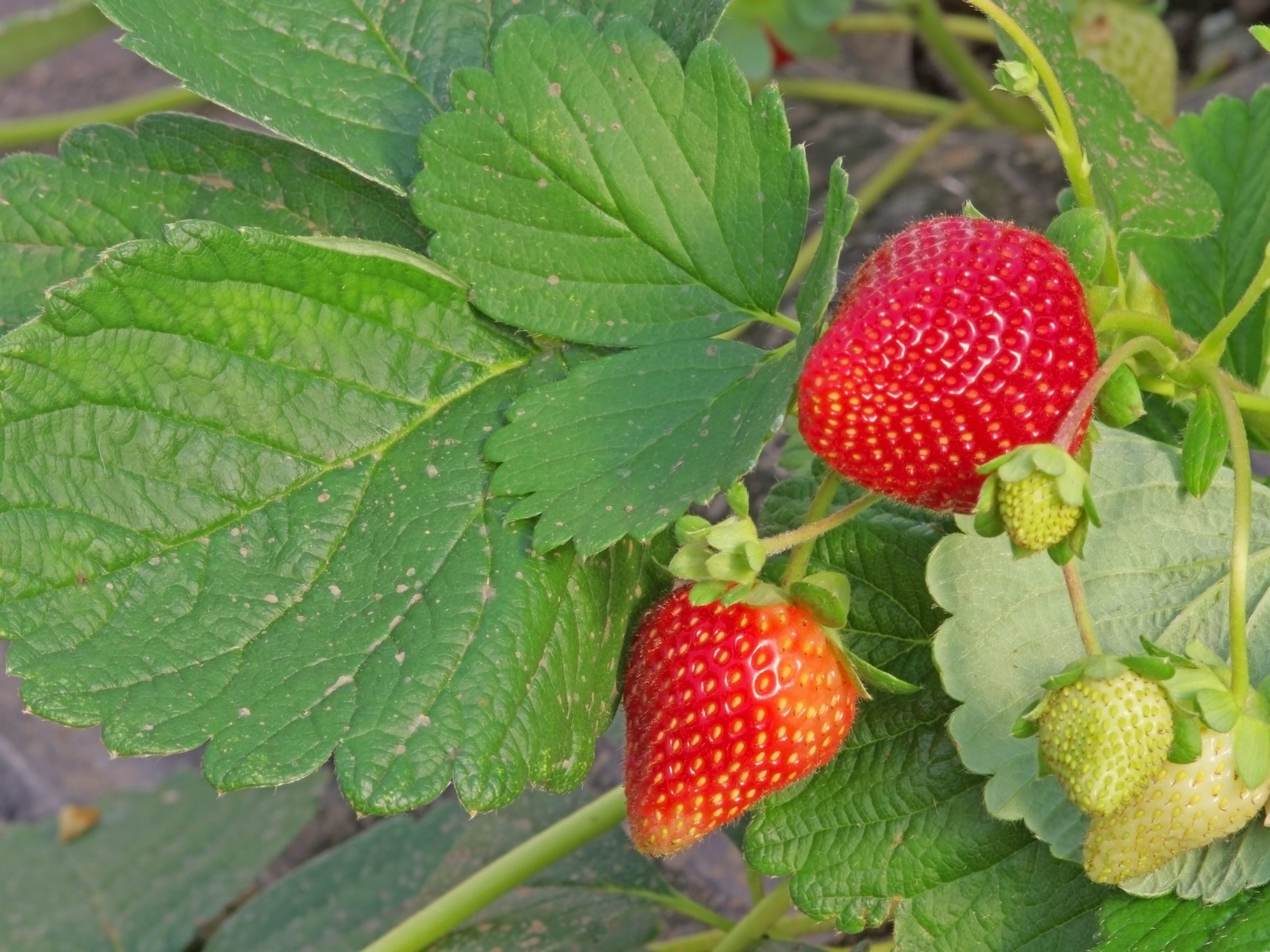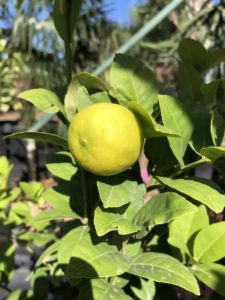 Improved Meyer Lemon: The original Meyer lemon was introduced from China by plantsman Frank Meyer. It is believed to be a cross between and orange and a lemon, which gives the plant more cold-hardiness. The Meyer lemon was a popular backyard fruit tree for many years, until in the 1940’s it was identified as a carrier of a deadly citrus tristeza virus. Most of the Meyer lemons were destroyed to protect the citrus industry, and it wasn’t until the 1970’s that a virus-free strain, the “improved Meyer” lemon was introduced.
Improved Meyer Lemon: The original Meyer lemon was introduced from China by plantsman Frank Meyer. It is believed to be a cross between and orange and a lemon, which gives the plant more cold-hardiness. The Meyer lemon was a popular backyard fruit tree for many years, until in the 1940’s it was identified as a carrier of a deadly citrus tristeza virus. Most of the Meyer lemons were destroyed to protect the citrus industry, and it wasn’t until the 1970’s that a virus-free strain, the “improved Meyer” lemon was introduced.
Meyer lemons grow to about 8’-10’, but will remain smaller in a pot. Mature trees can be winter hardy to 22 degrees F, but plants in pots should be protected at 32 degrees. Meyer lemons differ from other citrus in that they flower and fruit continuously as long as conditions are favorable. This can be confusing at harvest time, as fruit will be ripening over a longer period of time. Generally, a fruit will take 6-9 months to ripen, depending on the conditions. While some fruits may be ripe while still green on one end, waiting until the entire fruit is a golden yellow, with a glossy finish on the peel, will give you more consistent gauge as to ripeness. Of course, picking one and tasting it is always the best method!
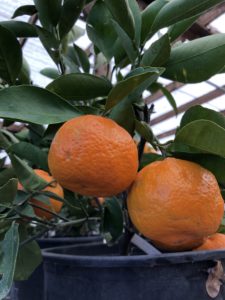
Satsuma mandarin oranges: Satsumas were first sent to the U.S. in 1878 by the wife of a U.S. minister to Japan, who named them after the former Provence of Satsuma, where they are believed to have originated. They are very suited to growing in a pot, and will rarely get over 6’ tall. They are a sweet orange, and there are many varieties to choose from, each ripening at a different time and thus spreading out the season. Some varieties are more winter-hardy than others, with the Arctic Frost and Orange Frost being the most winter-hardy, tolerating a short time at 9 degrees F. at the Overton Experiment Station at Texas A&M.

Persian Limes (aka Bearss or Tahiti limes): Persian limes were introduced into California between 1850 and 1880. While it is believed to have come from Tahiti, it is also thought to have come from Persian. Hence the different common names. The fruit is large, and is the variety often found in grocery stores. The trees flower and set fruit from Feb. to April, or even longer in warm climates. The fruit ripens in 3-6 months, and achieves its juiciness and flavor when the rind turns yellow. (Yes, yellow!) The fruit is usually seedless. It may be grown in a pot and maintained at 6’ tall for ease of picking.
 Calamondin Oranges Citrus mitis is a fairly cold-hardy (20°F) acid orange that was introduced to the U.S. from China in the early 1900’s. Like Kumquats, Calamondins produce 4-5 flushes of growth a season, with each flush producing flowers and setting fruit. This makes the Calamondin valuable as a patio tree, as the orange blossom fragrance fills the air. I keep mine in a pot outside the back door so that I can enjoy the citrus blossoms as I come and go.The Calamondin has a small fruit with thin skin and few seeds. The sour, acid juice may be used like lemon and lime to flavor beverages, fish or tea. The fruit can take up to a year to ripen and should be clipped off the stem to avoid damaging the skin. Since they do not keep well, they should be picked fresh. Although I have seen some planted in the ground in Central Texas, I prefer growing mine in a container. However, since they are not a grafted citrus, if they were to freeze back to the ground, they would come back true to type. This is a fun fruit to grow that produces a copious amount of fruit.
Calamondin Oranges Citrus mitis is a fairly cold-hardy (20°F) acid orange that was introduced to the U.S. from China in the early 1900’s. Like Kumquats, Calamondins produce 4-5 flushes of growth a season, with each flush producing flowers and setting fruit. This makes the Calamondin valuable as a patio tree, as the orange blossom fragrance fills the air. I keep mine in a pot outside the back door so that I can enjoy the citrus blossoms as I come and go.The Calamondin has a small fruit with thin skin and few seeds. The sour, acid juice may be used like lemon and lime to flavor beverages, fish or tea. The fruit can take up to a year to ripen and should be clipped off the stem to avoid damaging the skin. Since they do not keep well, they should be picked fresh. Although I have seen some planted in the ground in Central Texas, I prefer growing mine in a container. However, since they are not a grafted citrus, if they were to freeze back to the ground, they would come back true to type. This is a fun fruit to grow that produces a copious amount of fruit.
 Mexican Limes, also known as Key Limes, are one of the most frost-tender of the citrus grown in Central Texas. The fruits are small, about 1 ½” in diameter, and usually reach maturity in the fall. The ideal time to harvest these limes is when the color has changed from dark green to light green, the surface is smooth and the fruit seem slightly soft to the touch. They are usually quite thorny, but thornless varieties are available. If grown from seed, the plants will be thorny. Mexican Limes should always be grown in a pot and protected from freeze. They can be quite productive, and are a favorite citrus to grow in our area.
Mexican Limes, also known as Key Limes, are one of the most frost-tender of the citrus grown in Central Texas. The fruits are small, about 1 ½” in diameter, and usually reach maturity in the fall. The ideal time to harvest these limes is when the color has changed from dark green to light green, the surface is smooth and the fruit seem slightly soft to the touch. They are usually quite thorny, but thornless varieties are available. If grown from seed, the plants will be thorny. Mexican Limes should always be grown in a pot and protected from freeze. They can be quite productive, and are a favorite citrus to grow in our area.
Palestinian Sweet Lime, AKA Indian Sweet Lime, is much esteemed in India, the Near East, Egypt and Latin America. The flesh is pale yellow, tender and juicy with some seeds. Lacking acid, the fruit is sweeter than traditional limes. At maturity the rind is pale green to orange-yellow.
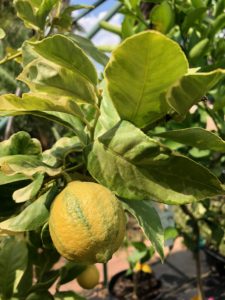
Eureka Variegated Pink Lemons were developed from a mutant branch found on an ordinary Eureka lemon in Burbank, California around 1930. This lemon sports glossy green and cream leaves with pink buds and pink fleshed fruit. The immature lemons have green striped skin, ripening to yellow. These trees are frost tender in Central Texas and are best grown in a container.
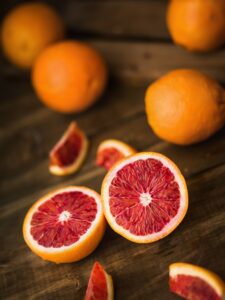
Cara Cara Red Navel Orange Easy to peel seedless fruit is prized by chefs and mixologists. This tree can be kept to 6′-8′ with careful pruning and will still produce a bounty of fruit. Zone 11
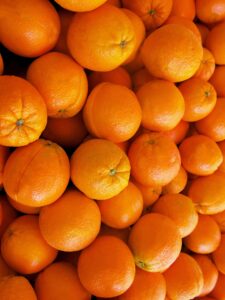
Hamlin Sweet Orange This is possibly the world’s principal variety of early maturing sweet orange. It produces a medium sized sweet, juicy fruit with few seeds.
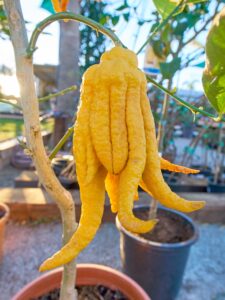
Buddha’s Hand Citron is a shrubby grower, producing 6”-12” fruits that resemble a human hand. The fruit usually ripens between November and January. The tree is very popular in Japan as a gift for New Year’s, for it is believed to bestow good fortune on a household. The fruit is solid on the inside and the rind may be used for zest. This citrus is cold sensitive and requires protection from frost and freeze.
Flying Dragon Rootstock is a “dwarfing” rootstock of the Trifoliate Orange, Poncirus trifoliate. When standard sized fruit trees are grafted onto this root stock, it will limit the size of the tree without sacrificing fruit size or production.


